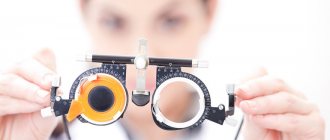Vision is the most important ability of a person and when deprived of it, he becomes more vulnerable. Therefore, any changes that occur in the eyes are very alarming.
Medicine knows quite a lot of ways to correct and correct vision, including:
- Medication (including instillation of vitamins that improve eye function);
- Laser (using the latest technologies and special laser installations);
- Surgical (in some situations, surgery is really the only way to save or restore vision);
- Alternative (which includes all non-medical procedures, including folk remedies, which are often not approved by medical science).
One of the alternative, harmless (when performed correctly) methods of vision correction is gymnastic exercises for the eyes. There are enough examples, which were combined into a single course of treatment by the famous public figure Vladimir Georgievich Zhdanov.
Exercises
Vladimir Georgievich advises starting any gymnastics for the eyes with a warm-up - palming. This term was introduced by W. Bates and means the following simple exercise.
So, it is better to perform it while sitting at a table, resting your elbows on the surface. The eyes are covered with eyelids, and on top, with palms folded in a special way. There should be no pressure on the eyes. Thus, the eyes are completely at rest for some time (several minutes). This relieves tension, improving blood circulation and the functioning of the optic nerves.
There are quite a few steps in a full set of eye exercises, so it’s worth highlighting the simplest and most necessary of them.
Zhdanov: a complete set of exercises to restore vision
The vision restoration complex from Zhdanov includes several basic exercises, let’s look at them in more detail.
Palming is one of the most popular exercises. It should be done if your eyes are tired from working at a computer or other work that puts strain on the eye apparatus. To begin, you need to rub your palms together. After this, close your eyes with already warmed hands so that no light penetrates. Sit with your eyes closed for about 5 minutes. After this, your eyes will feel great and you can get back to work. It is important to note that the exercise time can be increased depending on the degree of eye fatigue.
Gymnastics to restore vision
Below we will present a set of exercises with which you can effectively restore your vision. You can combine the complex with the first exercise (palming).
Before starting exercises, make sure that you have no contraindications and that you can do them. Contraindications may be:
- retinal detachment
- recent eye surgery.
Be sure to take off your glasses when performing exercises. Complex gymnastics needs to be repeated 3 times, but if it’s difficult for you, you can start with 1 and gradually increase. You need to repeat the exercises 3 times a day.
The first exercise is up and down. The first step is to raise your gaze as high as possible, the second step is to lower your gaze downwards. after this, you need to blink well.
The second exercise is left-right. First you need to look left, then right, then blink.
The third exercise is diagonal. First you need to look up diagonally, then down. Then blink.
The fourth exercise is a rectangle. For this exercise you need to draw a small rectangle with your gaze. First this must be done clockwise, then counterclockwise. After you complete the exercise, you need to blink.
The fifth exercise is a circle. You need to draw a circle, clockwise, and then counterclockwise.
So, this is the basic gymnastics that is necessary to restore vision in case of farsightedness. Professor Zhdanov, complete restoration of vision by 100 percent is not just a loud headline, it is something that is truly accessible to everyone. Anyone can restore their vision, but it will take some effort.
Video lessons
So, if you are serious about restoring your vision, then the best option for you is to do exercises with the help of video lessons. You can find videos such as Zhdanov and a full range of vision restoration videos. But why should you choose video format? It has a number of advantages, let's consider them in more detail.
First, you can clearly observe how this or that exercise is performed. After all, it is better to see once than to hear 100 times. After watching the video, you will be able to understand exactly how to perform this or that exercise, and what to pay attention to when performing it. This is a very effective option for performing exercises correctly.
Second, you can perform the exercises at the same time as the video is playing. This is very motivating and allows you not to give up halfway.
Thus, using a video complex is truly an excellent solution for those who want to achieve 100 results from the complex in the shortest possible time. This will be much easier with the help of video.
Morning exercises
In the morning, both the muscles of the body and the eyes need a little warm-up. Therefore, it will not be superfluous to learn how to systematically perform such exercises.
- Deep and even breathing should accompany all exercises. This condition is very important, because only the correct distribution of oxygen contributes to the normal functioning of the body. Therefore, breathing evenly, stretch a couple of times and turn over from one side to the other.
- Simultaneous opening of the eyes and mouth, and this must be done several times as widely as possible.
- Close your eyes as tightly as possible. Then open your eyes and repeat this exercise at least 6 times.
- Blink your eyes 12 times in quick, light movements.
- “Draw” several letters or numbers with your nose. This exercise is repeated 3-4 times. It relieves tension in the cervical spine.
- Palming. The exercise described above, for which it is enough to allocate 2-3 times per minute.
- Rotate with your fingers (it’s easiest to rotate your fingers randomly in different directions), while rotating, count to 10.
All morning exercises can take up to 15 minutes in total. It should pass calmly, without tension. And, if you decide to do it before getting ready for work, then it is better to get up early so that the lesson does not go in a hurry.
Eye muscle training
What is it for?
Any muscle training improves nutrition and blood supply to cells, any cells. When a cell is properly nourished, its functions naturally improve. We train all muscle groups that surround our eyeball.
The fact is that in ordinary life, when we need to look somewhere, for example, upward, we simply raise our heads. If we need to look to the left, we turn our heads, but do not squint our eyes.
Therefore, our muscles weaken somewhat over time. What doesn't work doesn't train!
At work
Whatever activity you engage in, be sure to devote at least 8-10 minutes to eye exercises. This will allow you to take a short break and give your eyes a rest. This is especially important for people whose profession involves prolonged eye strain (working with a computer, text documents, driving, etc.).
During the break, just palming is enough. It will relieve tension from the eyes and improve reaction. While doing the exercises, you need to remember to breathe. If you have intermittent, agitated breathing, you should not perform gymnastics. It is better to set aside time for it later in peace, otherwise it will not give the desired positive effect and result at all.
The next exercise from the complex proposed by Zhdanov can help effectively relax the eye muscles and improve well-being. When performing it, you should write several numbers, letters, and shapes in the air with your nose. Such movements will improve blood flow in the cervical region, relieve nervous tension, relieve headaches and fatigue.
In conclusion, I would like to mention that all of the above exercises are good for all people, regardless of visual acuity, physical or mental activity.
How to train your eye muscles?
We do each exercise 6-8 times.
- 1. We hold our head straight and move our eyes up and down with maximum amplitude to the point of slight tension. At the same time, you must maintain a smile, posture and good mood. We blink often.
- 2. We try to look at the left and right ears. The rest is the same - we do it until the muscles are slightly tense, remembering about posture. At the end we blink a lot.
- 3. We draw a butterfly with our eyes in the sequence: top to bottom, diagonal, top to bottom, diagonal. Then we change the direction: from bottom to top, diagonal, etc. This is how our oblique eye muscles are trained. They blinked.
- 4. Draw a large vertical figure eight and change direction. Then we “put” this figure eight on its side and we get an infinity sign. We also draw it in both directions. They missed it. We blink often.
- 5. Draw a big, big circle with eyes. This exercise can be done absolutely at any time. It is not advisable to do it only when your eyes are tired. No need to put extra strain on your eyes! We blink often.
While doing the exercises, we be sure to connect our psycho-emotional state - we try to feel that we have love inside us, care for our eyes. We must still be in a very good mood inside, then the effectiveness of our training will only increase.
A little about the author
Vladimir Georgievich Zhdanov is the chairman of the Sobriety Union, a person whose activities are entirely aimed at helping people fight addictions. By the way, Zhdanov considers wearing glasses one of these bad habits. Therefore, the course of gymnastic exercises for the eyes he proposed collected the work of many famous personalities who went in this direction. For example, in his lectures Zhdanov often refers to the Shichko-Bates method.
In the medical department, everyone can undergo examination using the most modern diagnostic equipment, and based on the results, receive advice from a highly qualified specialist. The clinic is open seven days a week and operates daily from 9 a.m. to 9 p.m. Our specialists will help identify the cause of vision loss and provide competent treatment for identified pathologies.
You can make an appointment at the Moscow Eye Clinic by calling 8 8 (499) 322-36-36 (daily from 9:00 to 21:00) or using the online registration form.
Who is Professor Zhdanov?
Professor Zhdanov is a well-known Russian public figure. It promotes non-medical methods of recovery from addictions such as smoking and drinking, as well as vision restoration. Professor V.G. Zhdanov conducts courses on vision restoration; they are based on the Bates method, which has not been recognized by science. Zhdanov conducts various thematic lectures, mainly on the topics of getting rid of addictions and restoring vision. Also, one of the popular topics of his lectures is the topic of therapeutic fasting.
The professor has published several books, leads various projects, and participates in conferences.
Features of the exercises
Zhdanov insists that wearing glasses or lenses is a bad habit! This only negatively affects visual acuity, and the eye muscles also weaken, and vision drops even lower. The best result is to perform complex exercises for the eye muscles, and then vision will be at the same level and improve over time.
Restoring vision according to Zhdanov, the full course consists of a number of exercises. There are some features of performing the exercises, thanks to them, the result will be as effective as possible. Let's look at them in more detail.
Firstly, before you start doing the exercises, you need to thoroughly understand, understand and remember the theoretical part. It is very important. After all, the exercises must be performed correctly, only in this case they will have an effect. And in order to perform the exercises correctly, you need to understand the theory well.
Secondly, you need to do the exercises every day, without skipping. Consistency is the key to success in any business, including taking Zhdanov’s course.
Thirdly, the exercises must be performed strictly as stated in the course.
So, we have looked at the main features of performing the exercises, it is worth saying that this is very important and for a good result they must be followed.
Gymnastics by Professor Zhdanov for astigmatism
People whose myopia is accompanied by astigmatism are recommended to regularly perform palming, as this exercise effectively relieves spasm, relaxes the eyes, prevents the development of various complications and prevents the progression of myopia.
During palming, an optimistic attitude is important; you need to think about something pleasant, evoking positive emotions. Zhdanov recommends getting out of palming painlessly, so you need to alternately close your eyes, blink them quickly, gradually getting used to the lighting.
The eye muscles are well relaxed using the solarization method. Eye exercises can be performed with a candle, in front of a lamp, or facing the sun. You need to focus your gaze on the light source, and then turn your head so that your eyes remain motionless. When performing this exercise in the sun, your eyes should be closed. Once they get used to the lighting, you can open them a little, but the pupil should be lowered down.
Palming technique
Preparation
- Close your eyes.
- Place your palms, bent into a cup shape, over the area around the eyes so that the base of the palm touches the nose.
- Place the first phalanges of the little fingers on top of each other, crossing them on the bridge of the nose at an angle of 90°, and cross the fingers on the forehead.
- Palms do not touch eyes.
Performance
- When performing palming, you should experience complete comfort, coziness and warmth.
- Choose a convenient time and place to do the exercises so that no one distracts or disturbs you.
- Try to relax, relieve tension in the muscles of your face, shoulders, neck and other parts of the body.
- At this time, you can listen to classical music, let your thoughts soar freely, think about pleasant things.
- Put away unpleasant thoughts and promise to deal with them later.
Completion
- When finishing palming, removing your hands from your face, do not open your eyes immediately - wait a few seconds, and then open them.
- Everyone determines the required duration of the exercise individually, 4 minutes is the minimum, 5 minutes is the permissible optimal time.
How to track the results of eye gymnastics
I had an illustrative case in practice. I asked the teenager:
—
Have you done gymnastics for your eyes?
-
Yes, I did, but I quit.
-
Why?
—
I didn’t see the result
.
This is very important - to see the result!
Why? Because myopic people, as they saw not very well, continue to see not very well. But if your vision does not deteriorate, if it does not fall, is this not the result? I think this is a very good result.
How can you understand whether there is a result or no result? There is a very simple way to do this. It is called “determining a further point of clear vision.” It is measured once a month, there is no need to measure it every week. It is determined for each eye separately, without correction, that is, without glasses, under the same conditions. The result must be recorded somewhere.
You take the small text. This could be an annotation for medications, for example, or any other finely written text. Moreover, you always use the same text. Cover one eye with your palm and move the text to a distance where you can’t see it. And you start to slowly get closer.
When you bring the piece of paper just enough to see it, you need to fix the distance from the lower orbital bone (under the eye) to the text - this will be your further point of clear vision.
If your further point of clear vision remains in place from month to month, your vision does not deteriorate. If it increases by 1 or 2 centimeters, then your vision subjectively improves. But if your point of closest vision begins to rapidly approach, you are doing something wrong and you should definitely contact an ophthalmologist! This will be your cue to do so.
Online consultation with an ophthalmologist
consultation cost: 500 rubles
Online consultation
During the consultation, you will be able to voice your problem, the doctor will clarify the situation, answer your questions and give the necessary recommendations.
Prevention of myopia in children - which gymnastics to choose?
A course for the prevention of myopia in children should include simple exercises that would be convenient to perform without prior preparation. It is important that the child is motivated and interested in doing gymnastics; this will improve the quality of exercise and put him in the right mood.
Children can be offered simple exercises for myopia, taken from the original methods of Professor Zhdanov, Bates, Avetisov:
- “dark-light” - you need to close your eyes for a couple of seconds and open them again, doing five repetitions; Children find it interesting to open and close their eyes, and the exercise improves blood supply to the visual organs;
- “arrows” - follow imaginary clock hands in a circle;
- “far-close” - look at objects located far away, and then move your gaze to the nearest object, thus training the accommodative muscle;
- rapid blinking of the eyes with a break of two seconds, repeat five times;
- alternating horizontal eye movements with vertical ones; you can use bright toys, asking children to follow them.
To ensure that exercise is not too tiring, it is better to choose no more than five effective exercises and repeat them up to four times a day. Gymnastics for the eyes for myopia with alternating movements improves blood circulation in the vessels of the visual organs and helps relieve eye fatigue.
The result obtained from the exercise
If palming is successful, it is one of the best ways to relax the eyes and all other senses. This method allows you to achieve complete relaxation, which persists after opening your eyes. At the same time, a person’s vision improves for a long time, pain in the eyes decreases for a long time, headaches disappear, as well as pain in other parts of the body.
Such cases are rare, but they do occur. With little relaxation, a significant part of it is lost when a person opens his eyes, and the small part that is preserved is retained for a short time.
Visualization of "blackness"
The quality of darkness that appears when palming is an indicator of the condition of your vision. Scientists have found that blackness in the field of vision develops independently and improves vision. You can experiment with “visualizing blackness” while palming; this technique can be very effective.
The object of visualization can be any black objects that you can think of and imagine how they quickly change each other. You can scroll through the letters of the alphabet, but the font must be black. When you reach the letter “I,” you need to compare its blackness with the blackness surrounding your field of vision. If the letter has a blacker color, imagine that it blends into the surrounding background. This process is repeated several times until the blackness becomes intense.
Do I need to wear glasses?
People who interact with a computer for a long time, working with information that requires increased visual stress, should pause in their activities and perform exercises that relieve eye fatigue and improve blood circulation. Which technique should you choose?
Many provisions of the author's methods for improving vision are criticized by practicing ophthalmologists. This mainly concerns the authors’ recommendations to completely abandon glasses. From the point of view of official medicine, this approach is harmful, since insufficient correction can provoke the progression of myopia. The eyes will be overly stressed and tired, which can be fraught with a spasm of accommodation, a change in the shape of the eyeball, and an increase in intraocular pressure.
Therefore, experts offer patients methods that do not raise doubts about the effectiveness of the approach. Restoring vision using the Zhdanov method is one of these, but ophthalmologists still do not recommend giving up wearing glasses. By performing a course of exercises every day, several times a day, you can relieve the spasm of accommodation, improving your vision by 2-3 diopters. Such exercises are also necessary for people with true myopia, as they help prevent the progression of myopia. To prevent myopia, astigmatism, and farsightedness, you can choose exercises according to Zhdanov, a course of exercises according to Bates, Norbekov.
Correct visual habits
What useful habit should you develop and be sure to instill in your children?
Under no circumstances should you bend low when you read and write!
Each person has his own distance from the eyes to the writing surface. This is the “chamon distance” - from the elbow to the tip of the fingers that touch the temporal region. This is the ideal eye distance. As soon as you start to bend over, your muscle is overloaded. Moreover, the rate of load on this muscle increases exponentially.
When I teach “school of insight” classes, I always give the children this example: when you sit correctly, it’s the same as if you’re just walking down the street. But if you bend over even a little, it’s the same as if they put 50 kg on your shoulders, that is, a sack of potatoes. This is the load our ciliary muscle experiences.
So, in no case, under any circumstances, bend low when reading or writing. This is a basic visual habit!
If you are sitting at a computer, at a phone, at a tablet, at any gadget, please hang some picture somewhere away. It should be quite small, but you should be able to see it clearly.
For example, it could be a calendar with numbers and you should see them, or any emotional picture that you want to look at. Every 15-20 minutes of close-up work, you glance at this picture for 5-10 seconds.
Thus, if you study for an hour, read, write, sit at the computer, you should look into the distance 4 times and palm 2 times. These are real visual habits.
When I ask, “When do you do eye exercises,” most people answer that when they are sick and tired.
This is not entirely correct! You must be one step ahead, that is, not let them get tired.









